Screening Zinc Protoporphyrin-Forming Lactic Acid Bacteria to Replace Nitrite in Meat Products
Abstract
1. Introduction
2. Materials and Methods
2.1. Materials and Chemicals
2.2. Construction of ZnPP-Formation Model System
2.2.1. Preparation of Bacterial Culture
2.2.2. Preparation of the ZnPP-Formation Model System
2.2.3. Measurement of ZnPP-Formation Ability
2.3. Measurement of Bacterial FECH Activity
2.3.1. Pretreatment of Bacterial Extracellular and Intracellular Solutions
2.3.2. Determination of FECH Activity
2.4. Construction of Raw Minced Meat Model System
2.5. Instrumental Color and Visible Images
2.6. pH Measurement
2.7. Fluorescence Spectroscopy of ZnPP in Minced Meat Extracts
2.8. UV–Vis Absorption Spectroscopy
2.9. Statistical Analysis
3. Results and Discussion
3.1. Screening of ZnPP-Forming LAB
3.2. FECH Activity Analysis
3.3. Color Analysis and Visible Images
3.4. pH Changes
3.5. Fluorescence Spectrum Analysis
3.6. Absorption Spectra Analysis
4. Conclusions
Author Contributions
Funding
Institutional Review Board Statement
Informed Consent Statement
Data Availability Statement
Conflicts of Interest
References
- Majou, D.; Christieans, S. Mechanisms of the bactericidal effects of nitrate and nitrite in cured meats. Meat Sci. 2018, 145, 273–284. [Google Scholar] [CrossRef] [PubMed]
- Nikodinoska, I.; Baffoni, L.; Di Gioia, D.; Manso, B.; García-Sánchez, L.; Melero, B.; Rovira, J. Protective cultures against foodborne pathogens in a nitrite reduced fermented meat product. LWT-Food Sci. Technol. 2019, 101, 293–299. [Google Scholar] [CrossRef]
- Sun, F.D.; Kong, B.H.; Chen, Q.; Han, Q.; Diao, X.P. N-nitrosoamine inhibition and quality preservation of Harbin dry sausages by inoculated with Lactobacillus pentosus, Lactobacillus curvatus and Lactobacillus sake. Food Control 2017, 73, 1514–1521. [Google Scholar] [CrossRef]
- Yang, Q.H.; Liu, Q.; Chen, Q.; Li, M.; Kong, B.H. Research progress on the formation and chromogenic mechanism of zinc protoporphyrin and its replacement for nitrite in meat products. Food Sci. 2023, 44, 293–303. [Google Scholar] [CrossRef]
- Kong, L.J.; Deng, J.Y.; Wu, Y.; Ge, J.X.; Xu, B.C. Research progress on chromogenic mechanism and application of microorganisms for replacing nitrite in fermented meat products. Food Sci. 2023, 44, 301–308. [Google Scholar] [CrossRef]
- Sebranek, J.G.; Bacus, J.N. Cured meat products without direct addition of nitrate or nitrite: What are the issues. Meat Sci. 2007, 77, 136–147. [Google Scholar] [CrossRef]
- Deda, M.S.; Bloukas, J.G.; Fista, G.A. Effect of tomato paste and nitrite level on processing and quality characteristics of frankfurters. Meat Sci. 2007, 76, 501–508. [Google Scholar] [CrossRef]
- Cui, H.Y.; Gabriel, A.A.; Nakano, H. Antimicrobial efficacies of plant extracts and sodium nitrite against Clostridium botulinum. Food Control 2010, 21, 1030–1036. [Google Scholar] [CrossRef]
- Thippareddi, H.; Juneja, V.K.; Phebus, R.K.; Marsden, J.L. Control of Clostridium perfringens germination and outgrowth by buffered sodium citrate during chilling of roast beef and injected pork. J. Food Prot. 2003, 66, 376–381. [Google Scholar] [CrossRef]
- Liu, Y.; Mao, H.; Li, F.; Wang, J.; Sun, B. Applying of microbial fermentation on colorizing cured meat products. J. Chin. Inst. Food Sci. Technol. 2017, 17, 182–188. [Google Scholar] [CrossRef]
- Wakamatsu, J.; Nishimura, T.; Hattori, A. A Zn-porphyrin complex contributes to bright red color in Parma ham. Meat Sci. 2004, 67, 95–100. [Google Scholar] [CrossRef] [PubMed]
- Grossi, A.B.; Do Nascimento ES, P.; Cardoso, D.R.; Skibsted, L.H. Proteolysis involvement in zinc-protoporphyrin IX formation during Parma ham maturation. Food Res. Int. 2014, 56, 252–259. [Google Scholar] [CrossRef]
- Parolari, G.; Aguzzoni, A.; Toscani, T. Effects of processing temperature on color properties of dry-cured hams made without nitrite. Foods 2016, 5, 2304–8158. [Google Scholar] [CrossRef] [PubMed]
- Taketani, S.; Ishigaki, M.; Mizutani, A.; Uebayashi, M.; Numata, M.; Ohgari, Y.; Kitajima, S. Heme synthase (ferrochelatase) catalyzes the removal of iron from heme and demetalation of metalloporphyrins. Biochemistry 2007, 46, 15054–15061. [Google Scholar] [CrossRef]
- Tuan Thanh, C.; Ishigaki, M.; Kataoka, T.; Taketani, S. Ferrochelatase catalyzes the formation of Zn-protoporphyrin of dry-cured ham via the conversion reaction from heme in meat. J. Agric. Food Chem. 2011, 59, 12238–12245. [Google Scholar] [CrossRef]
- Wandersman, C.; Stojiljkovic, I. Bacterial heme sources: The role of heme, hemoprotein receptors and hemophores. Curr. Opin. Microbiol. 2000, 3, 215–220. [Google Scholar] [CrossRef]
- Zhu, W.; Wilks, A.; Stojiljkovic, I. Degradation of heme in gram-negative bacteria: The product of the hemo gene of neisseriae is a heme oxygenase. J. Bacteriol. 2000, 182, 6783–6790. [Google Scholar] [CrossRef]
- Saduzzaman, M.; Ohya, M.; Kumura, H.; Hayakawa, T.; Wakamatsu, J.I. Searching for high ZnPP-forming edible bacteria to improve the color of fermented meat products without nitrite/nitrate. Meat Sci. 2020, 165, 108109. [Google Scholar] [CrossRef]
- Ghadiri Khozroughi, A.; Kroh, L.W.; Schluter, O.; Rawel, H. Assessment of the bacterial impact on the post-mortem formation of zinc protoporphyrin IX in pork meat. Food Chem. 2018, 256, 25–30. [Google Scholar] [CrossRef]
- Kauser-Ul-Alam, M.; Toba, Y.; Hioki, S.; Hayakawa, T.; Kumura, H.; Wakamatsu, J.I. Lactococcus lactis Subsp. Cremoris produces zinc protoporphyrin IX both aerobically and anaerobically and improves the bright red color of fermented meat products. Foods 2020, 9, 1583. [Google Scholar] [CrossRef]
- Kauser-Ul-Alam, M.; Hayakawa, T.; Kumura, H.; Wakamatsu, J.I. High ZnPP-forming food-grade lactic acid bacteria as a potential substitute for nitrite/nitrate to improve the color of meat products. Meat Sci. 2021, 176, 108467. [Google Scholar] [CrossRef] [PubMed]
- Wu, Y.; Deng, J.Y.; Xu, F.R.; Li, X.M.; Kong, L.J.; Li, C.; Sheng, R.; Xu, B.C. The mechanism of Leuconostoc mesenteroides subsp. IMAU:80679 in improving meat color: Myoglobin oxidation inhibition and myoglobin derivatives formation based on multi enzyme-like activities. Food Chem. 2023, 428, 136751. [Google Scholar] [CrossRef] [PubMed]
- Kong, L.J.; Deng, J.Y.; Cai, K.Z.; Wu, Y.J.; Ge, X.; Xu, B.C. Evaluating the colour formation and oxidation effect of Leuconostoc mesenteroides subsp. IMAU:80679 combining with ascorbic acid in fermented sausages. Food Biosci. 2023, 52, 102478. [Google Scholar] [CrossRef]
- Wakamatsu, J.; Okui, J.; Ikeda, Y.; Nishimura, T.; Hattori, A. Establishment of a model experiment system to elucidate the mechanism by which Zn-protoporphyrin IX is formed in nitrite-free dry-cured ham. Meat Sci. 2004, 68, 313–317. [Google Scholar] [CrossRef]
- Adamsen, C.E.; Moller, J.K.; Parolari, G.; Gabba, L.; Skibsted, L.H. Changes in Zn-porphyrin and proteinous pigments in italian dry-cured ham during processing and maturation. Meat Sci. 2006, 74, 373–379. [Google Scholar] [CrossRef]
- Parolari, G.; Benedini, R.; Toscani, T. Color formation in nitrite-free dried hams as related to Zn-protoporphyrin IX and Zn-chelatase activity. J. Food Sci. 2009, 74, C413–C418. [Google Scholar] [CrossRef]
- Chen, Q.; Hu, Y.Y.; Wen, R.X.; Wang, Y.; Qin, L.; Kong, B.H. Characterisation of the flavour profile of dry fermented sausages with different NaCl substitutes using HS-SPME-GC-MS combined with electronic nose and electronic tongue. Meat Sci. 2021, 172, 108338. [Google Scholar] [CrossRef]
- Wu, Y.; Deng, J.L.; Xu, F.R.; Li, X.M.; Kong, L.J.; Li, C.; Xu, B.C. Zinc protoporphyrin IX generation by Leuconostoc strains isolated from bulged pasteurized vacuum sliced hams. Food Res. Int. 2023, 174, 113500. [Google Scholar] [CrossRef]
- Parolari, G.; Gabba, L.; Saccani, G. Extraction properties and absorption spectra of dry cured hams made with and without nitrate. Meat Sci. 2003, 64, 483–490. [Google Scholar] [CrossRef]
- Chau, T.T.; Ishigaki, M.; Kataoka, T.; Taketani, S. Porcine ferrochelatase: The relationship between iron-removal reaction and the conversion of heme to Zn-protoporphyrin. Biosci. Biotechnol. Biochem. 2010, 74, 1415–1420. [Google Scholar] [CrossRef]
- Dailey, H.A.; Dailey, T.A.; Wu, C.K.; Medlock, A.E.; Wang, K.F.; Rose, J.P.; Wang, B.C. Ferrochelatase at the millennium: Structures, mechanisms and 2Fe-2S clusters. Cell. Mol. Life Sci. 2000, 57, 1909–1926. [Google Scholar] [CrossRef] [PubMed]
- Gündoğdu, A.K.; Karahan, A.G.; Çakmakç, M.L. Production of Nitric Oxide (NO) by Lactic Acid Bacteria Isolated from Fermented Products. Eur. Food Res. Technol. 2006, 223, 35–38. [Google Scholar] [CrossRef]
- Wakamatsu, J.I.; Akter, M.; Honma, F.; Hayakawa, T.; Kumura, H.; Nishimura, T. Optimal pH of zinc protoporphyrin IX formation in porcine muscles: Effects of muscle fiber type and myoglobin content. LWT-Food Sci. Technol. 2019, 101, 599–606. [Google Scholar] [CrossRef]
- Hu, Y.Y.; Wang, H.; Kong, B.H.; Wang, Y.; Chen, Q. The succession and correlation of the bacterial community and flavour characteristics of Harbin dry sausages during fermentation. LWT-Food Sci. Technol. 2021, 138, 110689. [Google Scholar] [CrossRef]
- Zhang, X.; Kong, B.H.; Xiong, Y.L. Production of cured meat color in nitrite-free Harbin red sausage by Lactobacillus fermentum fermentation. Meat Sci. 2007, 77, 593–598. [Google Scholar] [CrossRef]
- Zhao, L.; Jin, Y.; Ma, C.; Song, H.; Li, H.; Wang, Z.; Xiao, S. Physico-chemical characteristics and free fatty acid composition of dry fermented mutton sausages as affected by the use of various combinations of starter cultures and spices. Meat Sci. 2011, 88, 761–766. [Google Scholar] [CrossRef]
- Essid, I.; Hassouna, M. Effect of inoculation of selected Staphylococcus xylosus and Lactobacillus plantarum strains on biochemical, microbiological and textural characteristics of a Tunisian dry fermented sausage. Food Control 2013, 32, 707–714. [Google Scholar] [CrossRef]
- De Maere, H.; Fraeye, I.; De Mey, E.; Dewulf, L.; Michiels, C.; Paelinck, H.; Chollet, S. Formation of naturally occurring pigments during the production of nitrite-free dry fermented sausages. Meat Sci. 2016, 114, 1–7. [Google Scholar] [CrossRef]
- Adamsen, C.E.; Moller, J.K.; Laursen, K.; Olsen, K.; Skibsted, L.H. Zn-porphyrin formation in cured meat products: Effect of added salt and nitrite. Meat Sci. 2006, 72, 672–679. [Google Scholar] [CrossRef]
- Wakamatsu, J.; Hayashi, N.; Nishimura, T.; Hattori, A. Nitric oxide inhibits the formation of zinc protoporphyrin IX and protoporphyrin IX. Meat Sci. 2010, 84, 125–128. [Google Scholar] [CrossRef]
- Wakamatsu, J.I.; Kawazoe, H.; Ohya, M.; Hayakawa, T.; Kumura, H. Improving the color of meat products without adding nitrite/nitrate using high zinc protoporphyrin IX-forming microorganisms. Meat Sci. 2020, 161, 107989. [Google Scholar] [CrossRef] [PubMed]
- De Maere, H.; Chollet, S.; Claeys, E.; Michiels, C.; Govaert, M.; De Mey, E.; Paelinck, H.; Fraeye, I. In vitro zinc protoporphyrin IX formation in different meat sources related to potentially important intrinsic parameters. Food Bioprocess Technol. 2016, 10, 131–142. [Google Scholar] [CrossRef]
- Morita, H.; Niu, J.; Sakata, R.; Nagata, Y. Red pigment of Parma ham and bacterial influence on its formation. J. Food Sci. 1996, 61, 1021–1023. [Google Scholar] [CrossRef]
- Morita, H.; Sakata, R.Y. Nitric oxide complex of iron (II) myoglobin converted from metmyoglobin by Staphylococcus xylosus. J. Food Sci. 1998, 63, 352–355. [Google Scholar] [CrossRef]
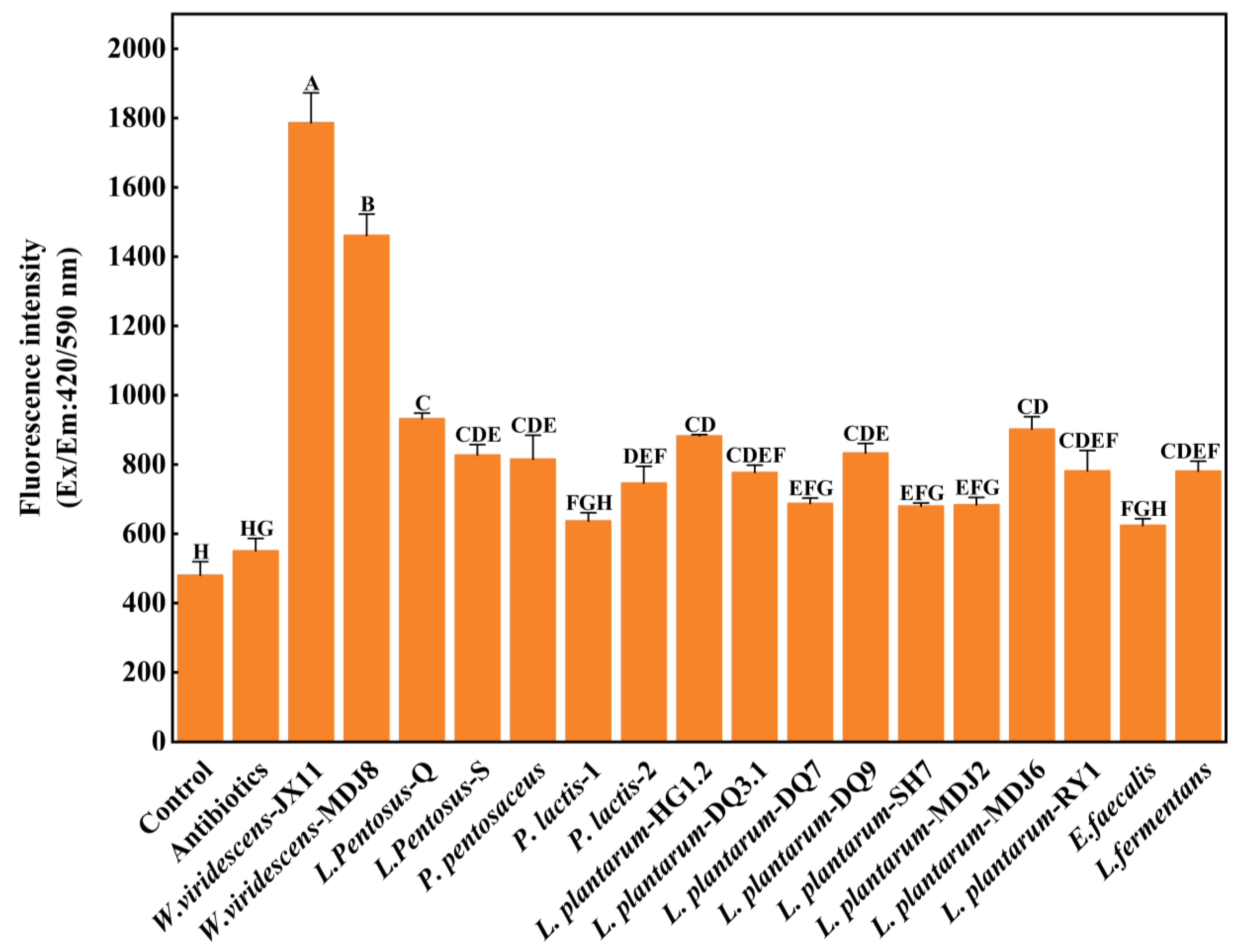
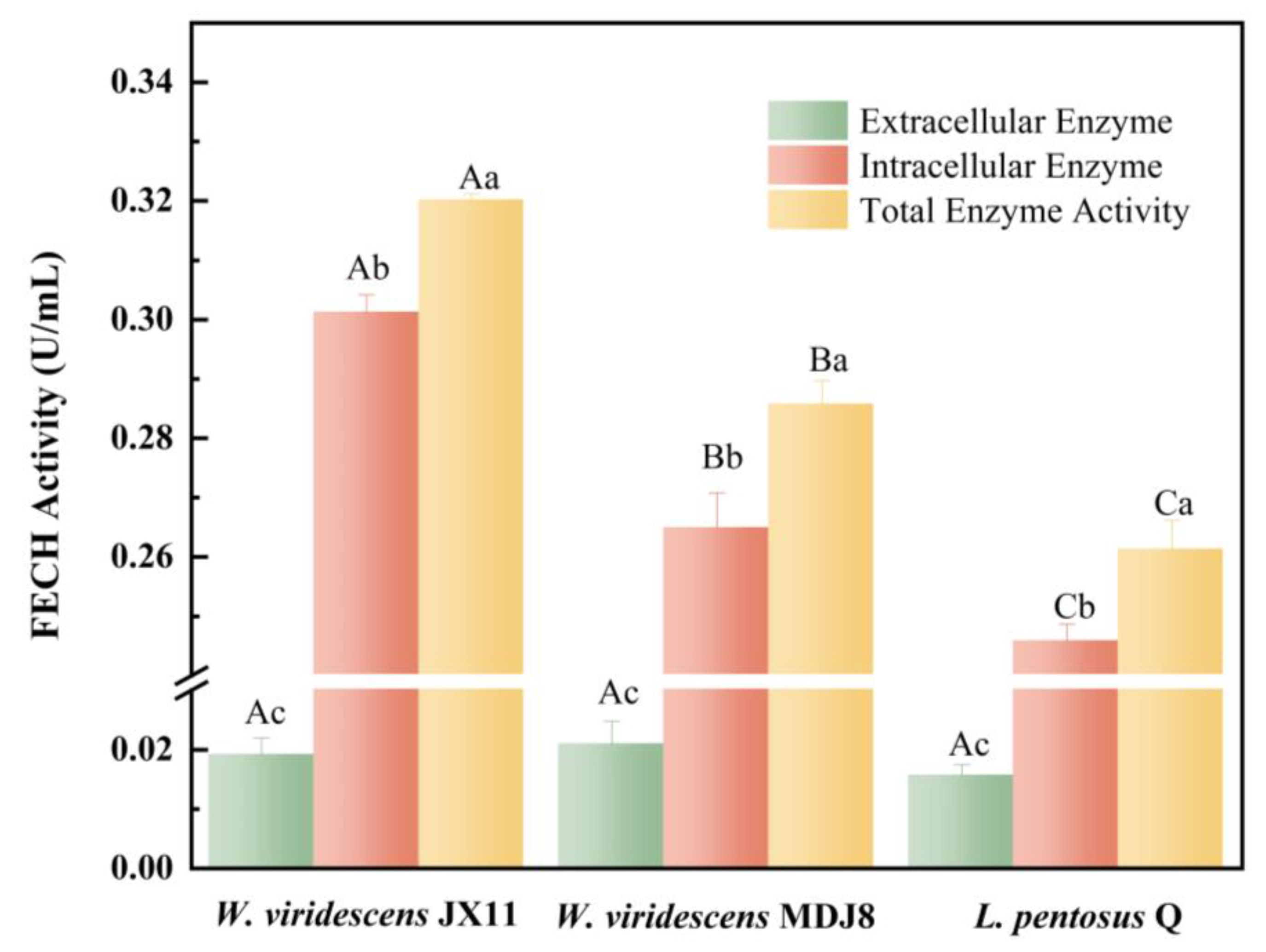
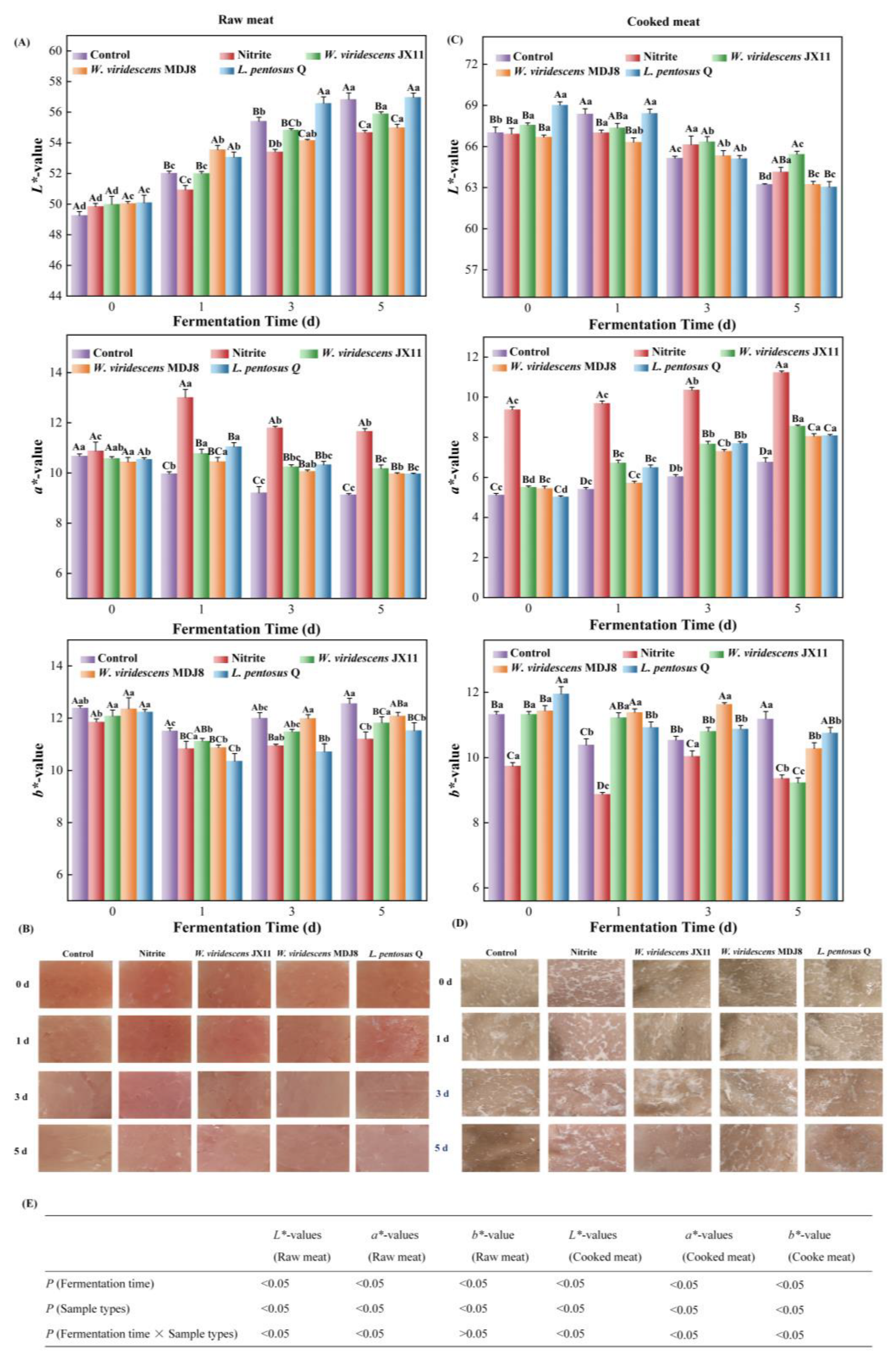
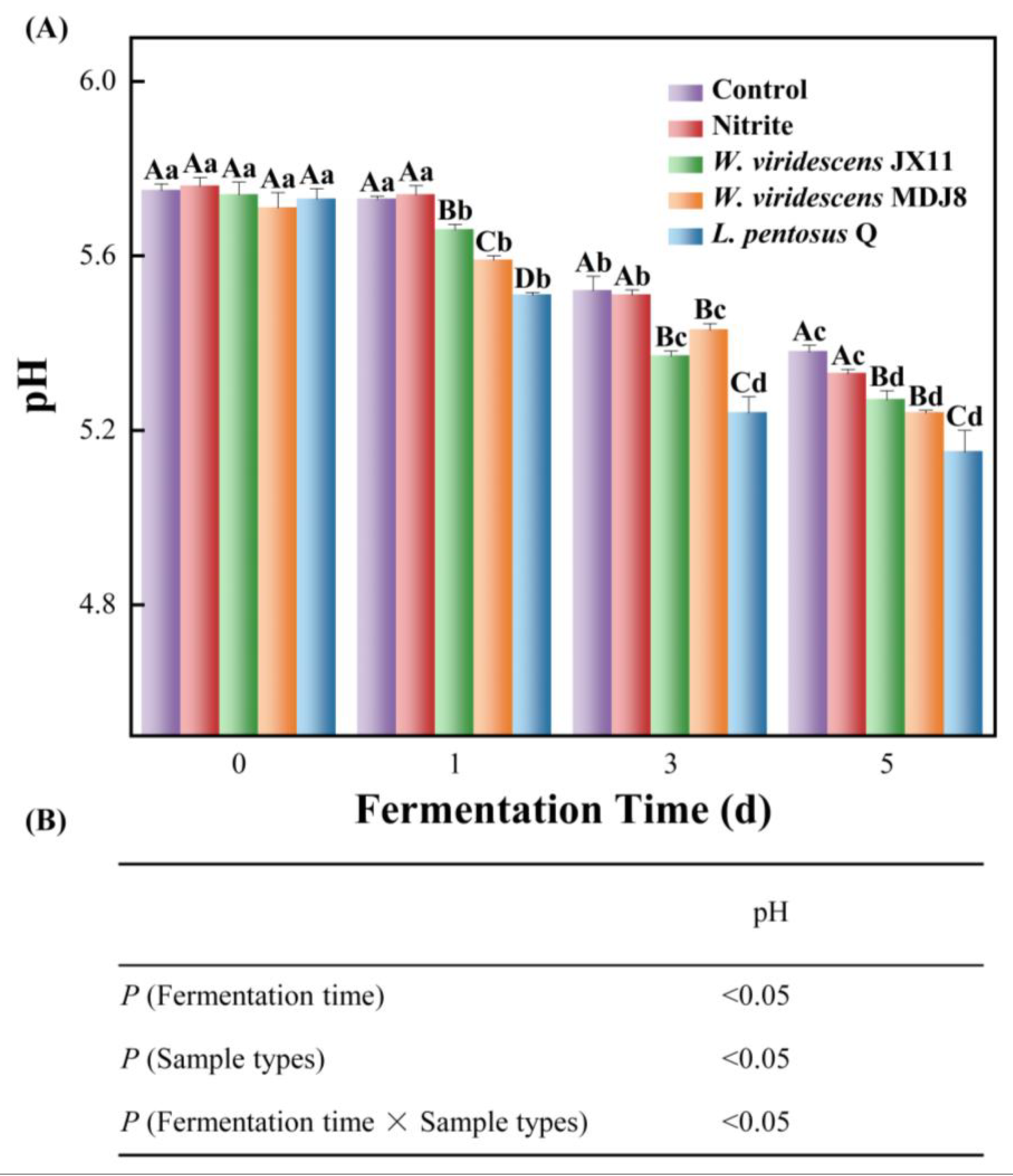
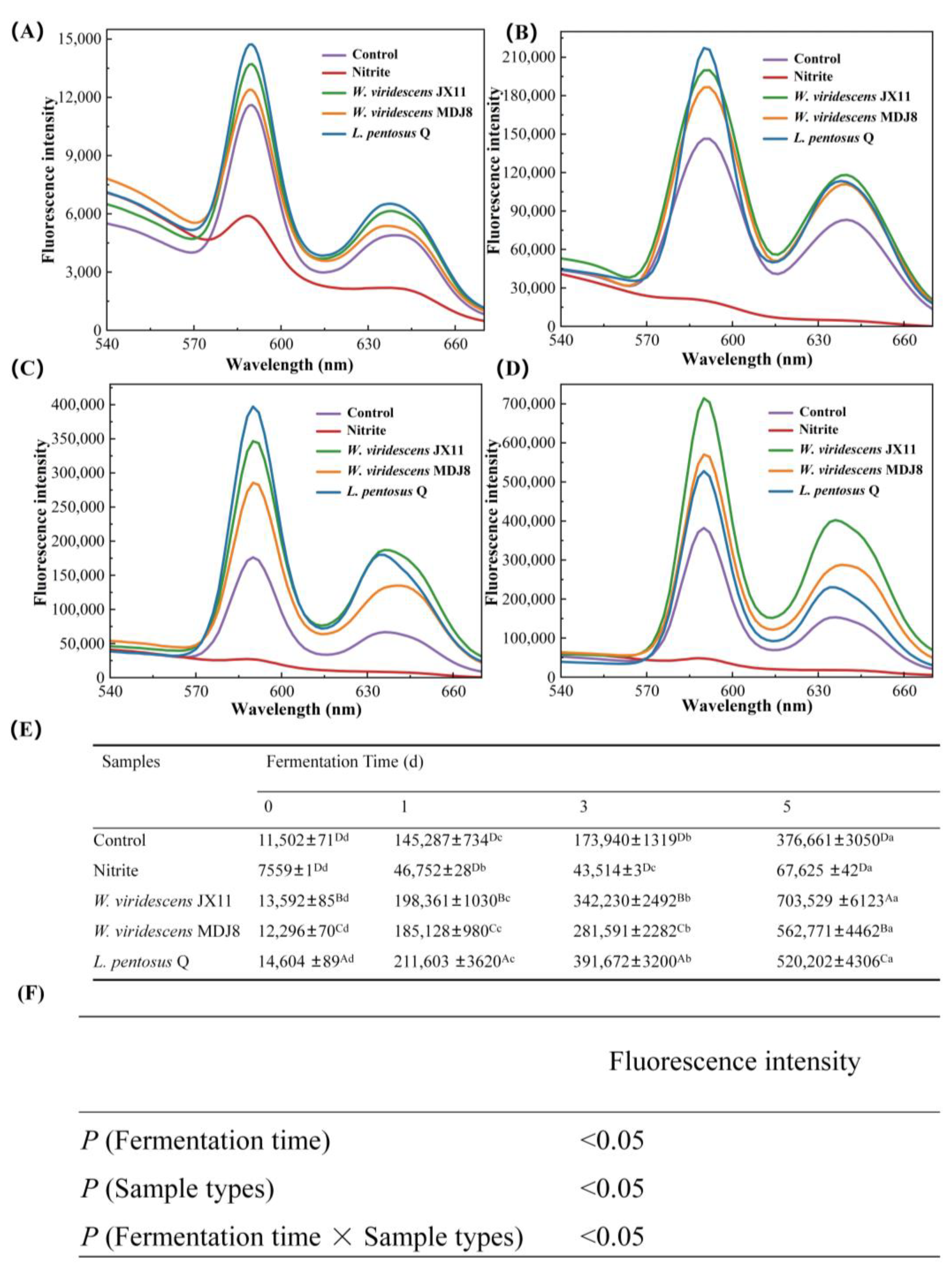
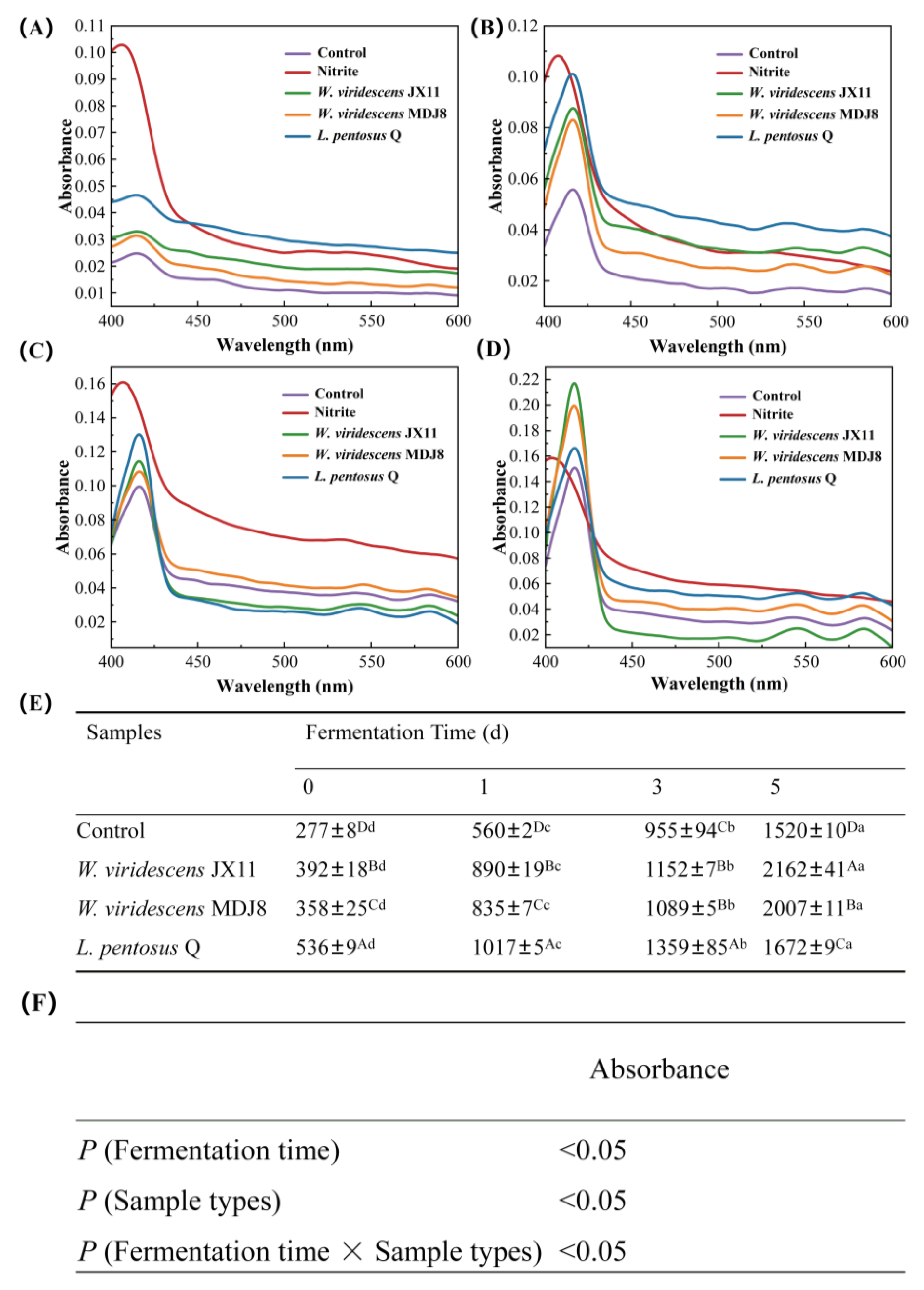
| Bacterial Name | Type | Source |
|---|---|---|
| Weissella viridescens | W. viridescens JX11 | Dry sausage |
| W. viridescens MDJ8 | ||
| Lactobacillus pentosus | L. pentosus Q | Shanghai Bioresources Collection Center |
| L. pentosus S | ||
| Pediococcus pentosaceus | P. pentosaceus | Dry sausage |
| Pediococcus lactis | P. lactis-1 | |
| P. lactis-2 | ||
| Lactobacillus plantarum | L. plantarum HG1.2 | Sauerkraut |
| L. plantarum DQ3.1 | ||
| L. plantarum DQ7 | Dry sausage | |
| L. plantarum DQ9 | ||
| L. plantarum SH7 | ||
| L. plantarum MDJ2 | ||
| L. plantarum MDJ6 | ||
| L. plantarum RY1 | ||
| Enterococcus faecalis | E. faecalis | |
| Lactobacillus fermentans | L. fermentans |
Disclaimer/Publisher’s Note: The statements, opinions and data contained in all publications are solely those of the individual author(s) and contributor(s) and not of MDPI and/or the editor(s). MDPI and/or the editor(s) disclaim responsibility for any injury to people or property resulting from any ideas, methods, instructions or products referred to in the content. |
© 2024 by the authors. Licensee MDPI, Basel, Switzerland. This article is an open access article distributed under the terms and conditions of the Creative Commons Attribution (CC BY) license (https://creativecommons.org/licenses/by/4.0/).
Share and Cite
Yang, Q.; Feng, Z.; Chen, Q.; Liu, H.; Liu, Q.; Sun, F.; Kong, B. Screening Zinc Protoporphyrin-Forming Lactic Acid Bacteria to Replace Nitrite in Meat Products. Foods 2024, 13, 3808. https://doi.org/10.3390/foods13233808
Yang Q, Feng Z, Chen Q, Liu H, Liu Q, Sun F, Kong B. Screening Zinc Protoporphyrin-Forming Lactic Acid Bacteria to Replace Nitrite in Meat Products. Foods. 2024; 13(23):3808. https://doi.org/10.3390/foods13233808
Chicago/Turabian StyleYang, Qianhui, Zhiqiang Feng, Qian Chen, Haotian Liu, Qian Liu, Fangda Sun, and Baohua Kong. 2024. "Screening Zinc Protoporphyrin-Forming Lactic Acid Bacteria to Replace Nitrite in Meat Products" Foods 13, no. 23: 3808. https://doi.org/10.3390/foods13233808
APA StyleYang, Q., Feng, Z., Chen, Q., Liu, H., Liu, Q., Sun, F., & Kong, B. (2024). Screening Zinc Protoporphyrin-Forming Lactic Acid Bacteria to Replace Nitrite in Meat Products. Foods, 13(23), 3808. https://doi.org/10.3390/foods13233808








